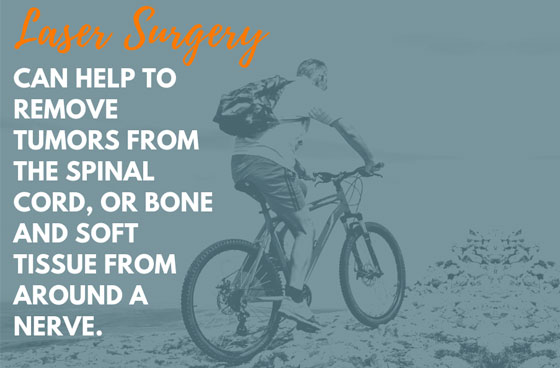The outpatient laser spine surgery technique is minimally invasive. It is performed with the latest in surgical technology. The small incisions and precise equipment used ensure minimal muscle damage and faster recovery.
Find Relief With Laser Spine Surgery
An innovative and safe approach that lets you recover more quickly.

Reduced muscle damage and smaller incisions translates to less pain, less risk of infection, and faster recovery. This is especially beneficial when it comes to managing post-surgical pain. With less discomfort, there is less need for pain medications.
With the minimally-invasive, outpatient approach, you are able to go home the same day of your surgery. This means that you can safely recover from your procedure in the comfort of your own home, with the help of your loved ones, rather than in the hospital.
How can you know that the outpatient laser spine surgery approach is right for you? Our doctors place emphasis on the overall care of each and every patient. Our only goal is to recommend the treatment methods that will benefit you the most. Your doctor will screen you thoroughly to determine if this surgery is right for you.
You can make your recovery go even further by following your doctor’s suggestions after surgery. You might need to work on correcting your posture, use a specialized pillow, or attend physical therapy. All of these suggestions are designed to make sure you stay free of pain.
Outpatient Laser Spine Surgery
If you’ve been dealing with spine-related pain, your first attempt at relief will likely be rest, over-the-counter medications, and various forms of physical therapy. But if such efforts aren’t providing meaningful relief, you may benefit from minimally invasive laser spine surgery.
What Happens Before Laser Spine Surgery?
Treatment for chronic back or neck pain doesn’t always mean surgery is your only option. Prior to considering any type of surgery, you will likely be prescribed certain pain or anti-inflammatory medications. You may be encouraged to modify your activities, apply heat and ice to the affected area, or try chiropractic manipulations to ease muscle tension and promote tissue healing.


If you reach a point where you are considering surgery, you will first undergo a thorough exam to identify the likely source of your back pain, neck pain, or arm and leg symptoms. Generally, preferred candidates for laser spine surgery are patients who can answer “yes” to one or more of the following questions:
- Has your spine-related pain lasted for 3-4 months or more?
- Have you tried physical therapy and other conservative treatments for 2-3 months without success?
- Is your discomfort consistently felt in the same area?
- Have you had previous open surgery for a spine-related problem that has failed to provide relief?
- Have you had a recent MRI, X-ray, or CT scan that has identified a specific problem such as a herniated disc or an abnormally narrow part of your spinal canal?
What Procedures May Benefit You?
If you answered “yes” to any of the above questions, you may benefit from laser spine surgery. The specific procedure recommended for you will depend on your source of spine-related pain. Many patients benefit from decompression procedures. The purpose of this type of surgery is to relieve nerve pressure. Discectomies, foraminotomies, and laminotomies are among the most commonly performed decompression procedures.
With a discectomy, part of a damaged spinal disc is removed. With a foraminotomy and laminotomy, specific structures in the spine are removed to increase space around nerves. Some patients benefit from a facet thermal ablation, a type of minimally invasive surgery for facet arthritis. A laser is used to eliminate arthritis affecting the facet joints in the affected area of the spine. A small incisions is created and a laser is used to deaden nerves. Because of the precision of the laser, nearby muscles and nerves aren’t disturbed.


For some patients, the most appropriate solution is the complete removal of a severely damaged disc. If this is necessary, stabilization surgery is often necessary to restore stability of the spine, which often means fusion surgery. An alternative to traditional open fusion surgery is minimally invasive stabilization surgery. It’s an approach to surgery that involves smaller incisions in the back or side. Surrounding muscles are moved, but not cut. The damaged disc is removed and an artificial disc is put in its place, which results in immediate stabilization.
What Happens After Laser Spine Surgery?
Many laser spine procedures are outpatient surgeries. Because of this, patients often enjoy a shorter recovery time and fewer surgery risks. You will still need to be careful with your movements after surgery as your spine heals and your muscles recover. You may also benefit from physical therapy to help recondition your soft tissues as you recover. You will be given specific instructions and recommendations about things like bathing and when it should be safe for you to return to work. Another benefit of minimally invasive laser spine surgery is a reduced dependence on pain medications, which can reduce the risk of experiencing problems with addiction.
Not all instances of back pain can be prevented, but there are steps you can take to reduce your odds of needing surgery, such as being mindful of your diet and how much exercise you get on a regular basis. If you have back or neck pain or related nerve pain causing discomfort in your arms, shoulders, or lower extremities that’s not going away with non-surgical treatment attempts, take comfort in knowing there are a growing number of outpatient laser spine surgery procedures that may provide relief.





